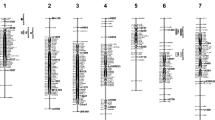Summary
Inbred lines possessing different genotypes at three isozyme loci, PGI-2, GOT-3 and ACP-1, were produced by two generations of selfing from two contrasting cultivars of perennial ryegrass. Four separate F2 populations were obtained by selfing or crossing F1 plants from crosses between cultivar inbred lines. F2 plants were scored for genotype at the three isozyme loci and for eight agronomic traits. The three isozyme loci showed independent segregation confirming that they belonged to separate linkage groups. A consistent association was observed between water soluble carbohydrate content and genotype at the PGI-2 locus. Some association was also detected between genotype at the ACP-1 locus and heading date. The relevance of these observations to ryegrass breeding programmes is discussed.
Similar content being viewed by others
References
Allard, R.W., 1956. Formulas and tables to facilitate the calculation of recombination values in heredity. Hilgardia 24: 235–278.
Cornish, M.A., M.D., Hayward & M.J., Lawrence, 1979. Selfincompatibility in ryegrass. I. Genetic control in diploid Lolium perenne L.. Heredity 43: 95–106.
Cornish, M.A., M.D., Hayward & M.J., Lawrence, 1980. Selfincompatibility in ryegrass. III. The joint segregation of S and PGI-2 in Lolium perenne L. Heredity 44: 55–62.
Evans, G.M., M.D., Hayward, J.W., Forster, N.J., McAdam, M.J., Scanlon, M., Stammers & J.A.K., Will, 1991. Genome analysis and its manipulation in Lolium. In: A.P.M., den, Nijs & A., Elgersma (Eds), Fodder crops breeding: Achievements, novel strategies and biotechnology. Proceedings of the 16th Meeting of the Fodder Crops Section of Eucarpia, Wageningen, The Netherlands, pp. 141–153. Pudoc, Wageningen, The Netherlands.
Hayward, M.D., 1991. Marker assisted selection in Lolium. In: AFRC Institute of Grassland and Environmental Research, 1990, Report. Ed. M., Robson, pp. 26. AFRC, IGER, Aberystwyth, Dyfed, UK.
Hayward, M.D. & N.J., McAdam, 1977. Isozyme polymorphism as a measure of distinctiveness and stability in cultivars of Lolium perenne. Z. Pflanzenzüchtg 79: 59–68.
Hayward, M.D. & N.J., McAdam, 1988. The effect of isozyme selection on yield and flowering time in Lolium perenne. Plant Breeding 101: 24–29.
Helentjaris, T., M., Slocum, S., Wright, A., Schaefer & J., Nienhuis, 1986. Construction of genetic linkage maps in maize and tomato using restriction fragment length polymorphisms. Theor. Appl. Gen. 72: 761–769.
Humphreys, M.O., 1989a. Water-soluble carbohydrates in perennial ryegrass breeding. I. Genetic differences among cultivars and hybrid progeny grown as spaced plants. Grass & Forage Science 44: 231–236.
Humphreys, M.O., 1989b. Water-soluble carbohydrates in perennial ryegrass breeding. II. Cultivar and hybrid progeny performance in cut plots. Grass & Forage Science 44: 237–244.
Humphreys, M.O., 1989c. Water-soluble carbohydrates in perennial ryegrass breeding. III. Relationships with herbage production, digestibility and crude protein content. Grass & Forage Science 44: 423–430.
Humphreys, M.O., 1991. A genetic approach to the multivariate differentiation of perennial ryegrass (Lolium perenne L.) populations. Heredity 66: 437–443.
Jones, T.W.A., 1985. The kinetics and thermal stability of phosphoglycoisomerase isozymes of ryegrasses (Lolium spp.). Physiol. Plant. 63: 365–369.
Jones, T.W.A., E., Pichersky & L.D., Gottlieb, 1986. Enzyme activity in EMS-induced null mutations of duplicated genes encoding phosphoglucose isomerases in Clarkia. Genetics 113: 101–114.
Keim, P., B.W., Diers, T.C., Olson & R.C., Shoemaker, 1990. RFLP mapping in soybean: Association between marker loci and variation in quantitative traits. Genetics 126: 735–742.
Kemp, D.R., C.F., Eagles & M.O., Humphreys, 1989. Leaf growth and apex development of perennial ryegrass during winter and spring. Annals of Botany 63: 349–355.
Lander, E.S. & D., Botstein, 1989. Mapping Mendelian factors underlying quantitative traits using RFLP linkage maps. Genetics 121: 185–199.
Lewis, E.J., M.W., Humphreys & M.P., Caton, 1980. Chromosome location of two isozyme loci in Lolium perenne using primary trisomics. Theor. Appl. Genet. 57: 237–239.
Luo, Z.W. & M.J., Kearsey, 1989. Maximum likelihood estimation of linkage between a marker gene and a quantitative locus. Heredity 63: 401–408.
Mather, K., 1951. The Measurement of Linkage in Heredity. Methuen, London.
Mather, K. & J.L., Jinks, 1971. Biometrical Genetics, pp. 119–124. Chapman and Hall, London.
McAdam, N.J., 1989. Linkage relationships in Lolium. In: AFRC Institute for Grassland and Animal Production, 1988 Report, Vol. 2 The Welsh Plant Breeding Station. Ed. C.F., Eagles, pp. 30, AFRC, IGAP, Maidenhead, UK.
Paterson, A.H., E.S., Lander, J.D., Hewitt, S., Peterson, S.E., Lincoln & S.D., Tanksley, 1988. Resolution of quantitative traits into Mendelian factors, using a complete linkage map of restriction fragment length polymorphism. Nature 335: 721–726.
Paterson, A.H., S., Damon, J.D., Hewitt, D., Zamir, H.D., Rabinowitch, S.E., Lincoln, E.S., Lander & S.D., Tanksley, 1991. Mendelian factors underlying quantitative traits in tomato: Comparison across species, generations and environments. Genetics 127: 181–197.
Rainey, D.Y., J.B., Mitton & R.K., Monson, 1987. Associations between enzyme genotypes and dark respiration in perennial ryegrass, Lolium perenne L. Oecologia 74: 335–338.
Scarrott, C.H., 1981. Self-incompatibility in diploid and tetraploid Lolium species. Ph. D. Thesis, University of Birmingham, UK.
Suiter, K.A., J.F., Wendel & J.S., Case, 1983. LINKAGE-1: a PASCAL computer program for the detection and analysis of genetic linkage. Journal of Heredity 74: 203–204.
Tanksley, S.D. & C.M., Rick, 1980. Isozymic gene linkage map of the tomato: Application in genetics and breeding. Theor. Appl. Genet. 57: 161–170.
Thomas, T.A., 1977. An automated procedure for the determination of soluble carbohydrates in herbage. Journal of the Science of Food and Agriculture 28: 639–642.
Thorogood, D. & M.D., Hayward, 1991. The genetic control of self-compatibility in an inbred line of Lolium perenne L. Heredity 67: 175–181.
Utz, H.F. & G., Oettler, 1978. Performance of inbred lines and their top crosses in perennial ryegrass (Lolium perenne L.). Zeitsch. Pflanzenzüchtg. 80: 223–229.
Wilkins, P.W., 1991. Breeding perennial ryegrass for agriculture. Euphytica 52: 201–214.
Wolff, K., 1987. Genetic analysis of ecological relevant morphological variability in Plantago lanceolata L. 2. Localisation and organisation of quantitative trait loci. Theor. Appl. Genet. 73: 903–914.
Author information
Authors and Affiliations
Rights and permissions
About this article
Cite this article
Humphreys, M.O. Association of agronomic traits with isozyme loci in perennial ryegrass (Lolium perenne L.). Euphytica 59, 141–150 (1992). https://doi.org/10.1007/BF00041266
Received:
Accepted:
Issue Date:
DOI: https://doi.org/10.1007/BF00041266



